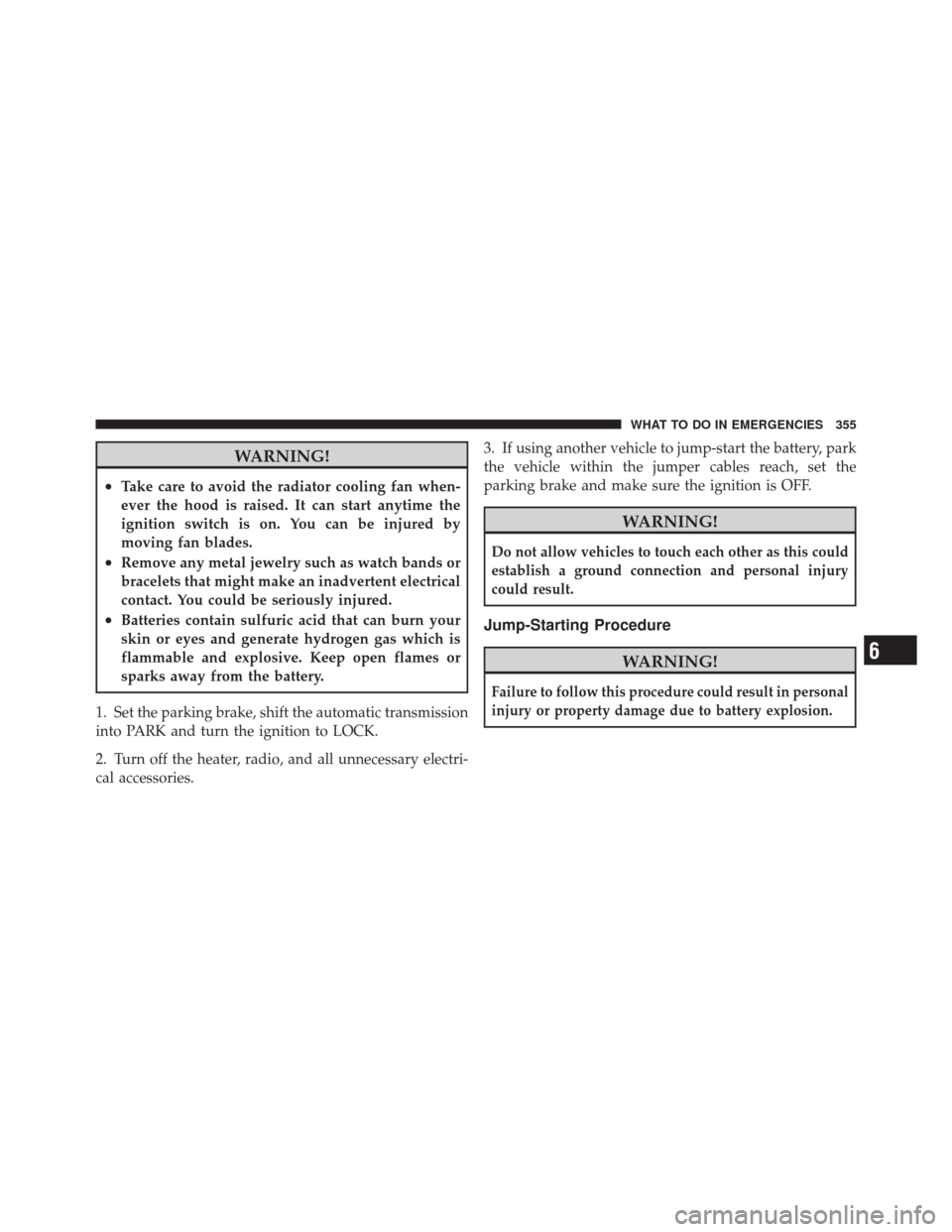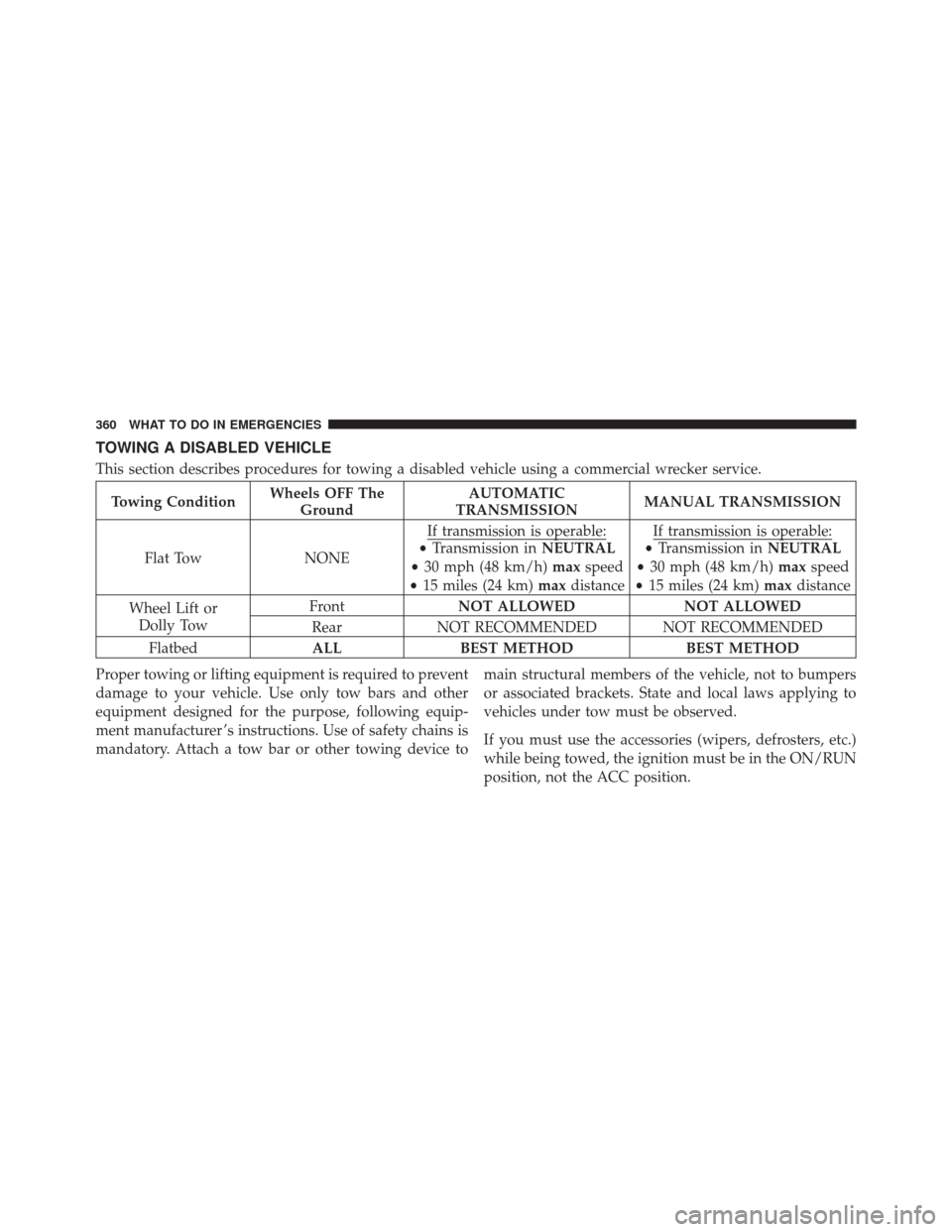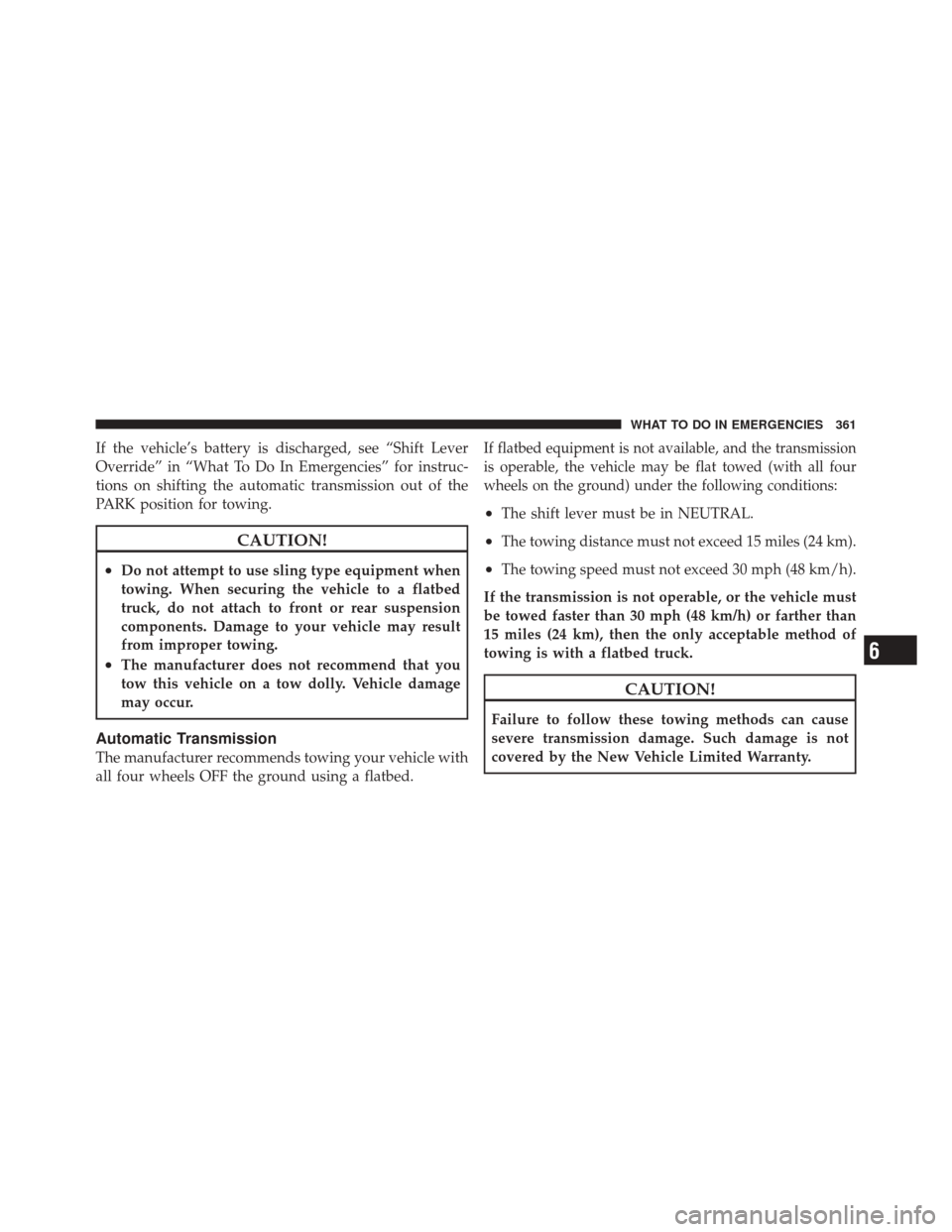Page 343 of 471
WHAT TO DO IN EMERGENCIES
CONTENTS
�Hazard Warning Flashers ................ 342
� If Your Engine Overheats ................ 342
� TIREFIT Kit ......................... 343
▫ TIREFIT Storage ..................... 344
▫ TIREFIT Kit Components And Operation . . . 344
▫ TIREFIT Usage Precautions ............. 346
▫ Sealing A Tire With TIREFIT ............ 348
� Jump-Starting Procedures ................ 353
▫ Preparations For Jump-Start ............. 354▫
Jump-Starting Procedure ............... 355
� Freeing A Stuck Vehicle ................. 357
� Shift Lever Override ................... 359
� Towing A Disabled Vehicle ............... 360
▫ Automatic Transmission ............... 361
▫ Manual Transmission ................. 362
▫ Without The Key Fob ................. 362
6
Page 357 of 471

WARNING!
•Take care to avoid the radiator cooling fan when-
ever the hood is raised. It can start anytime the
ignition switch is on. You can be injured by
moving fan blades.
•Remove any metal jewelry such as watch bands or
bracelets that might make an inadvertent electrical
contact. You could be seriously injured.
•Batteries contain sulfuric acid that can burn your
skin or eyes and generate hydrogen gas which is
flammable and explosive. Keep open flames or
sparks away from the battery.
1. Set the parking brake, shift the automatic transmission
into PARK and turn the ignition to LOCK.
2. Turn off the heater, radio, and all unnecessary electri-
cal accessories. 3. If using another vehicle to jump-start the battery, park
the vehicle within the jumper cables reach, set the
parking brake and make sure the ignition is OFF.
WARNING!
Do not allow vehicles to touch each other as this could
establish a ground connection and personal injury
could result.
Jump-Starting Procedure
WARNING!
Failure to follow this procedure could result in personal
injury or property damage due to battery explosion.
6
WHAT TO DO IN EMERGENCIES 355
Page 362 of 471

TOWING A DISABLED VEHICLE
This section describes procedures for towing a disabled vehicle using a commercial wrecker service.
Towing ConditionWheels OFF The
Ground AUTOMATIC
TRANSMISSION MANUAL TRANSMISSION
Flat Tow NONE If transmission is operable:
•
Transmission in NEUTRAL
• 30 mph (48 km/h) maxspeed
• 15 miles (24 km) maxdistance If transmission is operable:•
Transmission in NEUTRAL
• 30 mph (48 km/h) maxspeed
• 15 miles (24 km) maxdistance
Wheel Lift or Dolly Tow Front
NOT ALLOWED NOT ALLOWED
Rear NOT RECOMMENDED NOT RECOMMENDED
Flatbed ALLBEST METHOD BEST METHOD
Proper towing or lifting equipment is required to prevent
damage to your vehicle. Use only tow bars and other
equipment designed for the purpose, following equip-
ment manufacturer ’s instructions. Use of safety chains is
mandatory. Attach a tow bar or other towing device to main structural members of the vehicle, not to bumpers
or associated brackets. State and local laws applying to
vehicles under tow must be observed.
If you must use the accessories (wipers, defrosters, etc.)
while being towed, the ignition must be in the ON/RUN
position, not the ACC position.
360 WHAT TO DO IN EMERGENCIES
Page 363 of 471

If the vehicle’s battery is discharged, see “Shift Lever
Override” in “What To Do In Emergencies” for instruc-
tions on shifting the automatic transmission out of the
PARK position for towing.
CAUTION!
•Do not attempt to use sling type equipment when
towing. When securing the vehicle to a flatbed
truck, do not attach to front or rear suspension
components. Damage to your vehicle may result
from improper towing.
•The manufacturer does not recommend that you
tow this vehicle on a tow dolly. Vehicle damage
may occur.
Automatic Transmission
The manufacturer recommends towing your vehicle with
all four wheels OFF the ground using a flatbed.
If flatbed equipment is not available, and the transmission
is operable, the vehicle may be flat towed (with all four
wheels on the ground) under the following conditions:
•The shift lever must be in NEUTRAL.
•The towing distance must not exceed 15 miles (24 km).
•The towing speed must not exceed 30 mph (48 km/h).
If the transmission is not operable, or the vehicle must
be towed faster than 30 mph (48 km/h) or farther than
15 miles (24 km), then the only acceptable method of
towing is with a flatbed truck.
CAUTION!
Failure to follow these towing methods can cause
severe transmission damage. Such damage is not
covered by the New Vehicle Limited Warranty.
6
WHAT TO DO IN EMERGENCIES 361
Page 366 of 471

▫Cooling System ..................... 383
▫ Brake System ....................... 389
▫ Clutch Hydraulic System (Manual
Transmission) – If Equipped ............. 391
▫ Manual Transmission – If Equipped ....... 391
▫ Automatic Transmission – If Equipped ..... 392
▫ Rear Axle .......................... 393
▫ Appearance Care And Protection From
Corrosion .......................... 394
� Fuses .............................. 399
▫ Integrated Power Module .............. 399
▫ Rear Power Distribution Center .......... 402�
Vehicle Storage ....................... 406
� Replacement Bulbs .................... 407
� Bulb Replacement ..................... 408
▫ Low Beam Headlamp, High Beam
Headlamp, Park/Turn Lamp — Models With
Halogen Headlamps — If Equipped ....... 408
▫ Low Beam Headlamp, High Beam
Headlamp, And Park/Turn Lamp — Models
With High Intensity Discharge (HID)
Headlamps — If Equipped ............. 408
▫ Front/Rear Side Marker Lamp ........... 409
▫ Tail/Turn And Stop Lamp .............. 409
▫ Center Tail/Backup Lamp .............. 412
364 MAINTAINING YOUR VEHICLE
Page 369 of 471

ONBOARD DIAGNOSTIC SYSTEM — OBD II
Your vehicle is equipped with a sophisticated onboard
diagnostic system called OBD II. This system monitors
the performance of the emissions, engine, and automatic
transmission control systems. When these systems are
operating properly, your vehicle will provide excellent
performance and fuel economy, as well as engine emis-
sions well within current government regulations.
If any of these systems require service, the OBD II system
will turn on the “Malfunction Indicator Light” (MIL).
It will also store diagnostic codes and other information
to assist your service technician in making repairs. Al-
though your vehicle will usually be drivable and not
need towing, see your authorized dealer for service as
soon as possible.CAUTION!
•Prolonged driving with the MIL on could cause
further damage to the emission control system. It
could also affect fuel economy and drivability. The
vehicle must be serviced before any emissions
tests can be performed.
•If the MIL is flashing while the engine is running,
severe catalytic converter damage and power loss
will soon occur. Immediate service is required.
Loose Fuel Filler Cap
If the vehicle diagnostic system determines that the fuel
filler cap is loose, improperly installed, or damaged, a
”gASCAP” message will display in the odometer or a
“Check Gascap” message will display in the Electronic
Vehicle Information Center (EVIC) (if equipped). If this
occurs, tighten the fuel filler cap properly and press the
7
MAINTAINING YOUR VEHICLE 367
Page 394 of 471

Automatic Transmission – If Equipped
Selection Of Lubricant
It is important that the proper lubricant is used in the
transmission to assure optimum transmission perfor-
mance. Use only manufacturer ’s recommended transmis-
sion fluid. Refer to “Fluids, Lubricants, and Genuine
Parts” in “Maintaining Your Vehicle” for further informa-
tion. It is important that the transmission fluid be main-
tained at the prescribed level using the recommended
fluid. No chemical flushes should be used in any trans-
mission; only the approved lubricant may be used.
Special Additives
Automatic Transmission Fluid (ATF) is an engineered
product and its performance may be impaired by supple-
mental additives. Therefore, do not add any fluid addi-
tives to the transmission. The only exception to thispolicy is the use of special dyes to aid in detecting fluid
leaks. In addition, avoid using transmission sealers as
they may adversely affect seals.
CAUTION!
Do not use chemical flushes in your transmission as
the chemicals can damage your transmission compo-
nents. Such damage is not covered by the New
Vehicle Limited Warranty.
Fluid Level Check
Regular automatic transmission fluid level checks are not
required. For this reason, the dipstick is omitted.
If you notice fluid loss or gear shift malfunction, have
your authorized dealer check the transmission fluid level.
392 MAINTAINING YOUR VEHICLE
Page 417 of 471
Chassis
ComponentFluid, Lubricant, or Genuine Part
Manual Transmission –
If Equipped MOPAR�
ATF+4�Automatic Transmission Fluid or equivalent licensed
ATF+4� product.
Automatic Transmission –
If Equipped MOPAR�
ATF+4�Automatic Transmission Fluid or equivalent licensed
ATF+4� product.
Brake Master Cylinder MOPAR�DOT 3, SAE J1703 should be used. If DOT 3, SAE J1703 brake
fluid is not available, then DOT 4 is acceptable. Use only recommended
brake fluids.
Power Steering Reservoir MOPAR�Power Steering Fluid + 4, MOPAR� ATF+4�Automatic
Transmission Fluid or equivalent licensed ATF+4� product.
Rear Axle MOPAR�Synthetic Gear Lubricant SAE 75W90 (API GL-5) or equivalent
(with MOPAR� Friction Modifier — Hypoid Gear Additive).
7
MAINTAINING YOUR VEHICLE 415